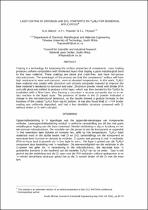 ResearchSpace
ResearchSpace
Laser coating of zirconium and ZrO(sub2) composites on Ti(sub6)Al(sub4)V for biomedical applications
JavaScript is disabled for your browser. Some features of this site may not work without it.
- ResearchSpace
- →
- Research Publications/Outputs
- →
- Journal Articles
- →
- View Item
| dc.contributor.author |
Baloyi, NM

|
|
| dc.contributor.author |
Popoola, API

|
|
| dc.contributor.author |
Pityana, Sisa L

|
|
| dc.date.accessioned | 2015-11-04T11:58:25Z | |
| dc.date.available | 2015-11-04T11:58:25Z | |
| dc.date.issued | 2014-05 | |
| dc.identifier.citation | Baloyi, NM, Popoola, API, and Pityana, SL. 2014. Laser coating of zirconium and ZrO(sub2) composites on Ti(sub6)Al(sub4)V for biomedical applications. South African Journal of Industrial Engineering, vol. 25(1), pp 62-70. | en_US |
| dc.identifier.issn | 2224-7890 | |
| dc.identifier.uri | http://hdl.handle.net/10204/8236 | |
| dc.description | Copyright: 2014 SAIIE. | en_US |
| dc.description.abstract | Coating is a technology for improving the surface properties of components. Laser coating produces uniform composition with thickened layers that display a good metallurgical bond to the base material. These coatings are dense and crack-free, and have non-porous microstructures. The advantages of the process are that the components’ surface will have high resistance to wear and corrosion, even at elevated temperatures. In this work, Ti(sub6)Al(sub4)V base material was coated with zirconium and zirconia composite material to improve the base material’s resistance to corrosion and wear. Zirconium powder mixed with binder (PVA and cold glue) was melted to produce a thin layer, which was then bonded to the Ti(sub6)Al(sub4)V by irradiation with a fibre laser, thus forming a zirconium + zirconia composite due to an in-situ reaction in the liquid state. The presence of binder in the Zr powder indicated a change in the microstructural behaviour, as the results showed a gradual increase in the hardness of the coated Ti(sub6)Al(sub4)V from top to bottom. It was also found that Zr + PVA binder coating was uniformly deposited, and had a less dendritic structure compared with Zr without binder or Zr with cold glue. | en_US |
| dc.language.iso | en | en_US |
| dc.publisher | South African Institute for Industrial Engineering (SAIIE) | en_US |
| dc.relation.ispartofseries | Worklist;14325 | |
| dc.subject | Laser coating | en_US |
| dc.subject | Zirconium | en_US |
| dc.subject | Biomedical applications | en_US |
| dc.title | Laser coating of zirconium and ZrO(sub2) composites on Ti(sub6)Al(sub4)V for biomedical applications | en_US |
| dc.type | Article | en_US |
| dc.identifier.apacitation | Baloyi, N., Popoola, A., & Pityana, S. L. (2014). Laser coating of zirconium and ZrO(sub2) composites on Ti(sub6)Al(sub4)V for biomedical applications. http://hdl.handle.net/10204/8236 | en_ZA |
| dc.identifier.chicagocitation | Baloyi, NM, API Popoola, and Sisa L Pityana "Laser coating of zirconium and ZrO(sub2) composites on Ti(sub6)Al(sub4)V for biomedical applications." (2014) http://hdl.handle.net/10204/8236 | en_ZA |
| dc.identifier.vancouvercitation | Baloyi N, Popoola A, Pityana SL. Laser coating of zirconium and ZrO(sub2) composites on Ti(sub6)Al(sub4)V for biomedical applications. 2014; http://hdl.handle.net/10204/8236. | en_ZA |
| dc.identifier.ris | TY - Article AU - Baloyi, NM AU - Popoola, API AU - Pityana, Sisa L AB - Coating is a technology for improving the surface properties of components. Laser coating produces uniform composition with thickened layers that display a good metallurgical bond to the base material. These coatings are dense and crack-free, and have non-porous microstructures. The advantages of the process are that the components’ surface will have high resistance to wear and corrosion, even at elevated temperatures. In this work, Ti(sub6)Al(sub4)V base material was coated with zirconium and zirconia composite material to improve the base material’s resistance to corrosion and wear. Zirconium powder mixed with binder (PVA and cold glue) was melted to produce a thin layer, which was then bonded to the Ti(sub6)Al(sub4)V by irradiation with a fibre laser, thus forming a zirconium + zirconia composite due to an in-situ reaction in the liquid state. The presence of binder in the Zr powder indicated a change in the microstructural behaviour, as the results showed a gradual increase in the hardness of the coated Ti(sub6)Al(sub4)V from top to bottom. It was also found that Zr + PVA binder coating was uniformly deposited, and had a less dendritic structure compared with Zr without binder or Zr with cold glue. DA - 2014-05 DB - ResearchSpace DP - CSIR KW - Laser coating KW - Zirconium KW - Biomedical applications LK - https://researchspace.csir.co.za PY - 2014 SM - 2224-7890 T1 - Laser coating of zirconium and ZrO(sub2) composites on Ti(sub6)Al(sub4)V for biomedical applications TI - Laser coating of zirconium and ZrO(sub2) composites on Ti(sub6)Al(sub4)V for biomedical applications UR - http://hdl.handle.net/10204/8236 ER - | en_ZA |





